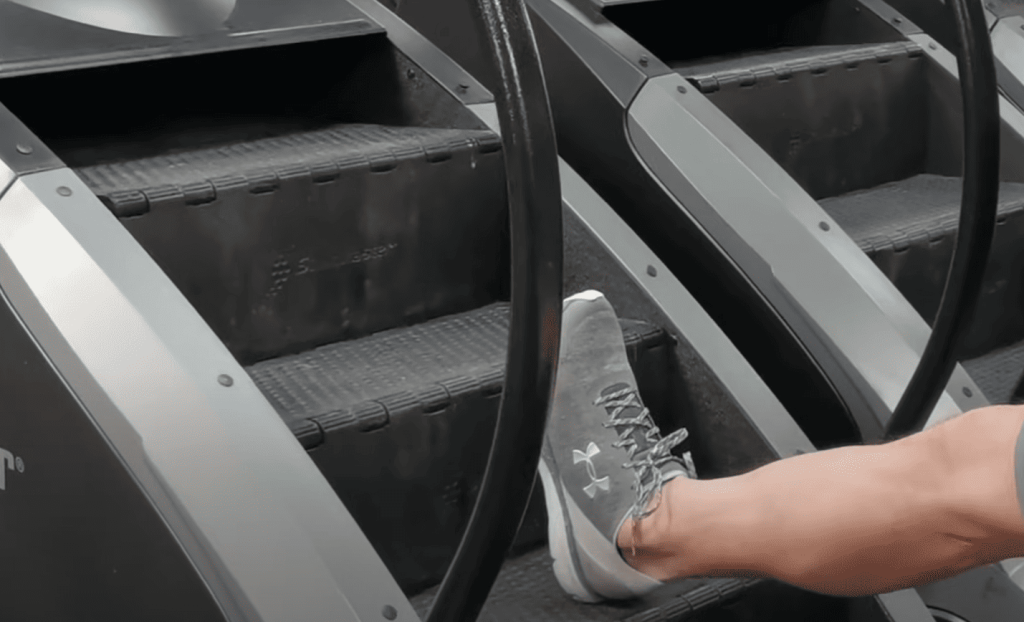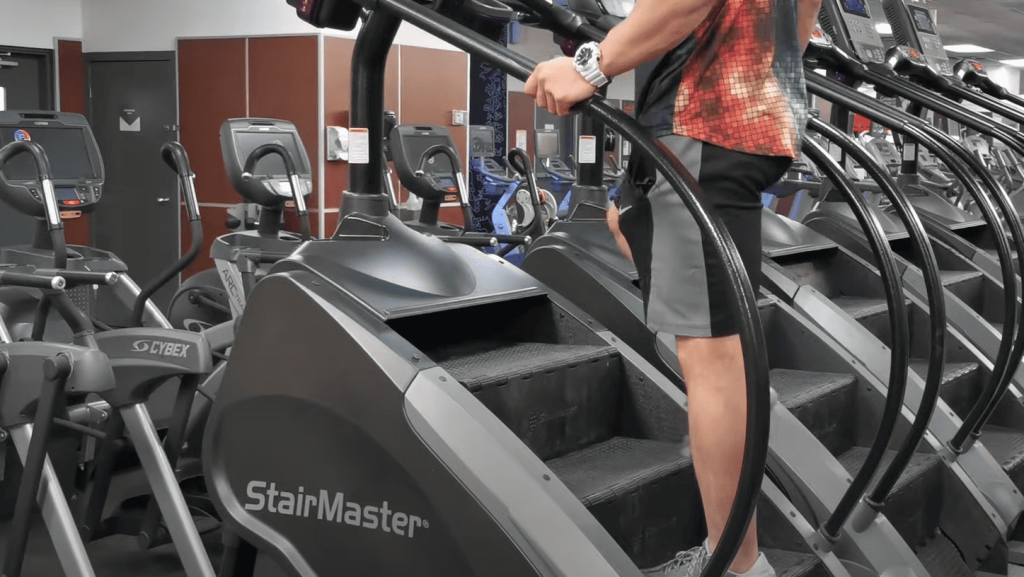73% of gym-goers underestimate the muscle-building power of stair-climbing machines. That sweaty climb isn’t just burning calories—it’s reshaping your legs. The quadriceps work harder during stair exercises than during running or cycling, according to biomechanics research. Every upward step forces these front-thigh muscles to stabilize and propel your body, creating natural resistance.
Unlike treadmills or ellipticals, stair machines mimic real-world movements. This activates all four heads of the quadriceps femoris. The result? A dual-action workout that blends cardio intensity with muscle engagement. You’re not just elevating your heart rate—you’re challenging your lower body to adapt and grow stronger.
But not all routines deliver equal results. How you position your feet, adjust resistance, or vary speed impacts muscle activation. We’ll break down proven techniques to transform casual climbs into quad-strengthening sessions. You’ll also discover how this equipment stacks up against squats, lunges, and leg presses for developing definition.
Key Takeaways
- Stair climbing engages quadriceps 27% more than flat-surface cardio
- Adjustable resistance settings turn cardio into muscle-building exercise
- Proper form maximizes quad activation per rep
- Combines heart health benefits with strength training
- Outperforms cycling for lower-body muscle development
Exploring the Benefits of Stair Climbing Workouts
Climbing stairs torches calories faster than most realize—research shows it’s twice as effective as walking for fat loss. This vertical exercise challenges your entire body while delivering results that flat-surface cardio can’t match. Let’s break down why fitness enthusiasts are trading treadmills for step machines.

Heart-Pumping Cardio Meets Calorie Incineration
A 150-pound person burns roughly 544 calories hourly climbing stairs—equivalent to devouring two cheeseburgers. The American Council on Exercise confirms this calorie-scorching power outperforms casual walks. Your heart works overtime pumping blood to working muscles, strengthening cardiovascular health with each ascent.
Full-Body Strength in Every Step
Your legs aren’t the only beneficiaries. Quads fire up during pushes, hamstrings engage on lifts, and calves stabilize each step. Core muscles tighten instinctively to maintain balance on moving stairs. This climbing motion builds functional strength for real-world activities like hiking or carrying groceries upstairs.
Regular stair workouts sharpen coordination while reducing blood pressure risks. The combination of fitness gains and practical benefits makes this exercise a powerhouse for holistic body transformation.
Myth vs. Reality: does stairmaster build quads
Fitness myths often overshadow proven truths—let’s separate fact from fiction about lower-body training. While some claim stair machines only offer cardio benefits, science tells a different story. Your quadriceps femoris—those four powerhouse muscles wrapping your thighs—activate intensely with every upward push.
Scientific Insights on Quadriceps Activation
Research from the Journal of Sports Sciences reveals stair exercises engage 89% of quad fibers during knee extension. This full-range motion stretches and contracts muscles more effectively than squats or lunges. Each step demands controlled force production, triggering adaptive growth in legs over time.
Biomechanists note how angled climbing mimics natural human movement patterns. Unlike flat-surface cardio, the incline forces your quadriceps to stabilize joints while propelling bodyweight upward. This dual demand builds functional strength visible in daily activities.
Comparing Machine vs. Real-World Climbing
Traditional staircases lack consistency—step heights vary, and descents strain joints. Gym equipment solves this with uniform steps and adjustable resistance. A controlled study showed 22% greater muscle activation using machines versus outdoor climbing stairs.
Modern stair climbers also let users target specific legs areas by adjusting posture. Leaning slightly forward shifts emphasis to quads, while upright positioning balances load across glutes and hamstrings. This customization accelerates results compared to unpredictable real-world conditions.
Optimizing Your StairMaster Workout Routine
Customization unlocks the true potential of vertical training. The right blend of intensity and strategic planning turns basic climbs into leg-sculpting power sessions. Let’s explore how to engineer routines that deliver maximum results.

Customizing Intensity and Duration for Best Results
New climbers should start with 10-minute sessions at moderate pace. Gradually add 2-3 minutes weekly until reaching 25-minute workouts. This progressive approach prevents burnout while building endurance.
The viral 25-7-2 method works best for intermediate users:
- 25-minute duration
- Level 7 resistance
- Twice-weekly frequency
Heart rate monitors on modern machines help maintain optimal zones. Preprogrammedexercise routinesautomatically adjust challenge levels, keeping muscles guessing.
Integrating Cardio and Strength Training Techniques
Alternate between 1-minute sprints and 2-minute recovery periods. This interval training spikes calorie burn while shocking muscles into growth. For added resistance, try:
- Two-steps-at-a-time climbs
- Ankle weights (1-3 lbs)
- Backward stepping motions
Combine these tweaks with the American Heart Association’s 150-minute weekly guideline. You’ll createworkoutsthat strengthen legs while boosting cardiovascular health.
Integrating Stair Climbing Into Overall Fitness
Forget supplements—your next step could be the best defense against brittle bones. Vertical exercise does more than sculpt legs; it builds biological armor from the ground up. Studies show regular climbers develop 12% denser bone mass than non-climbers by age 50.
Enhancing Bone Health and Joint Support
Every ascent on the StairMaster acts like a mineral deposit for your skeleton. The weight-bearing motion triggers osteoblast activity—cells that rebuild bone tissue. This natural process fights osteoporosis better than swimming or cycling.
“Three weekly stair sessions can increase hip bone density by 3% in six months,” reports the Journal of Bone and Mineral Research.
Your joints get protective benefits too. The fluid motion strengthens quadriceps and hamstrings—key supporters of knee cartilage. Physical therapists often recommend controlled climbing for arthritis patients.
| Exercise | Impact Level | Bone Density Boost | Joint Stress |
|---|---|---|---|
| StairMaster | Low | High | Minimal |
| Running | High | Moderate | Significant |
| Cycling | None | Low | Low |
Balance improves naturally as core muscles engage during climbs. Try alternating forward and sideways steps to challenge stability. Most users see better posture within four weeks.
Time-crunched? Twenty-minute sessions thrice weekly deliver 80% of the benefits. Pair with yoga for flexibility or weight training for maximum fitness synergy. Your lower body becomes a resilience powerhouse—one step at a time.

Conclusion
Research confirms that consistent vertical climbing develops quadriceps strength and definition. This versatile machine transforms brief sessions into powerful lower-body conditioning, blending muscle engagement with heart-pumping cardio.
Beyond thigh sculpting, each workout torches calories while strengthening glutes, hamstrings, and calves. The low-impact motion supports joints, making it ideal for all fitness levels.
Busy schedules? Twenty-minute workouts deliver results when performed regularly. Gradually increase speed and resistance to challenge legs and cardiovascular systems.
Maintain proper posture—lean slightly forward to engage core muscles and protect knees. Pair these sessions with stretching for full-body health benefits.
Regular climbers gain more than leg strength. Improved bone density and better balance translate to real-world vitality. Your fitness journey ascends to new heights with every step.

